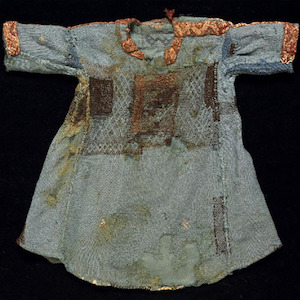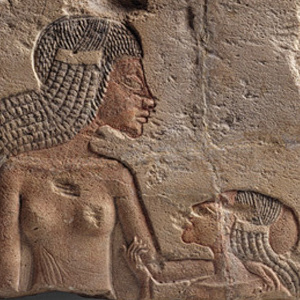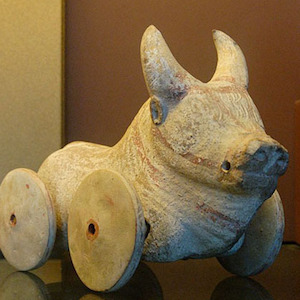Ancient (before 500 CE)

Tophet of Carthage
These images show a stone grave marker carved with symbols and a terracotta funerary urn containing the charred remains of an infant. The Tophet of Carthage is a cemetery for infants in the ruins of the North African city of Carthage, now located in a suburb of Tunis.

Paleolithic Finger Flutings Cave Drawing
This image from Chamber A1 of Rouffignac Cave was created by a young girl we posit to be between four and five years old from her height and the places in the cave where she has chosen to make her flutings.

Child's Sock
Archaeologist W. M. Flinders Petrie found this child's sock, dated to the 2nd century C.E., in a cemetery at Oxyrhyncus, a Greek monastic centre on the banks of the Nile in Egypt.

Infant's Tunics
These two infant tunics, found south of Cairo by archaeologists, date to the period after the Arab conquest of Egypt.

Children's Tunics
These two children's tunics, found in Egypt by archaeologist Wm. Flinders Petrie, date to the Islamic period, 9th or 10th century. The blue tunic measures 45.5 cm long and 51 cm wide (18 x 20 inches).

Mud Crocodile Toy
This small sculpture of a crocodile is made of Nile River mud, and was probably a toy fashioned by a child at play. The crocodile was a familiar monster to children living along the Nile—an object of fear and fascination.

Phoenician Baby Bottle
The Phoenician terracotta vessel features a human face, the nose forming a narrow spout. The bottle is an archaeological find from Carthage, near modern Tunis, dated to 399 BCE-200 BCE. Archaeologists believe this object was a baby bottle.

Two Daughters of Akhenaten
The bas-relief, or carved panel, in limestone shows two sisters embracing. They are princesses from the family of Akhenaten, the 18th pharaonic dynasty in ancient Egypt, dated to 1349–1336 BCE.

Buffalo on Wheels Toy
This object made from terracotta was most likely a child's pull toy. Approximately 11 centimeters high and 16.5 centimeters long (4.3 x 6.5 inches), it features functional wheels and a hole at the mouth for a string.

Mencius and his Mother: A Lesson Drawn from Weaving
This illustration depicts a scene from the Traditions of Exemplary Women (Lienü zhuan) of Liu Xiang (ca. 77-6 BCE), one of China's first didactic texts on feminine morality. The text to this story is provided below the illustration. The story recounts the upbringing of Mencius (ca.